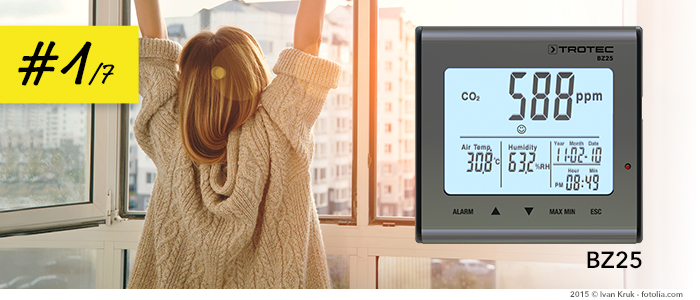If something appears to be especially valuable to us, we like to use this metaphor to illustrate it: “As important as the air we breathe!” But crucial for our well-being is a sufficient proportion of oxygen in the atmosphere. Yet this is quickly consumed in rooms where several people are at one time, while the level of CO2 exhaled constantly rises. Only regular and proper ventilation can remedy this – and ideally ventilation according to DIN standards!
Ventilation according to official DIN specifications is not a joke, but rather shows the enormous importance that experts attach to proper ventilation for a healthy indoor climate. Since people react to the continuous increase in the proportion of CO2 with an increased susceptibility to fatigue and a significant loss of performance. The air feels ‘stale’ and ‘stuffy’. For one thing, monitoring CO2 values in the air with items like the BZ25 CO2 air quality monitor or with the professional BZ30 CO2 air quality data logger from Trotec help reduce this. For another, the standard of the Deutsches Institut für Normung (DIN, German Institute for Standardisation) also makes quick and effective ventilation easy for you. Their standard stipulates how often and more importantly how long fresh air should be allowed into the room in order to guarantee a perfect indoor climate.
How to ventilate properly – according to DIN standards 1946-6
You should open the windows four times a day
- for at least 30 minutes in June, July and August,
- for 20 minutes in September and May,
- for 15 minutes in October and April,
- for 10 minutes in November and March,
- for 5 minutes from December to February.
Even if you are not at home during the day, you should still allow for draught in the rooms at least three times a day: ideally once early in the morning and twice in the evening. When doing this, it is important to open the windows fully and not just half-open them, as well as to always turn down the heating. And if you take a bath in the evening, a longer period of ventilation is of course worthwhile.
Cross ventilation ensures fast air exchange
Furthermore, experts suggest cross ventilating by opening windows opposite one another. This creates an airflow that quickly transports the stale air out of the room. If you do not have windows and doors opposite one another, you should simply ventilate for a little longer. And you will save energy if you turn down the heating as early as possible in advance and then only open the windows when the radiators have cooled down.
Ventilate for longer after energy-saving measures
If energy modernisation measures, such as insulation or replacing windows, have been carried out, rooms must be ventilated for longer, as air can no longer be replaced via air leaks.
Expose the concentration killer CO2
The BZ25 CO2 air quality monitor is ideally suited for offices, schools and preschools: It measures the CO2 content of the air in the room in 2-second phases. An indicator helps with orientation – is this value already at a critical level? If so, that means: open windows and ventilate! This is easily forgotten, namely in offices and schools. The BZ25 helps remind you of this.
The BZ30 CO2 air quality data logger is an ideal measuring device combo for architects, experts and any builders of air conditioning, ventilation and heating systems. The BZ30 not only measures CO2 concentration, temperature and humidity in the room, but can also save up to 50,000 measurements. This makes unsupervised long-term measurements possible.
Clean air – with innovative solutions from Trotec
Find out about all of the ways our CO2 air quality management could benefit you. And also make the most of our current offer: You will get the BZ25 CO2 air quality monitor for not 149.94 €, but for 129.95 € and the BZ30 CO2 air quality data logger for just £133.42 inc. VAT – in the Trotec shop now!


